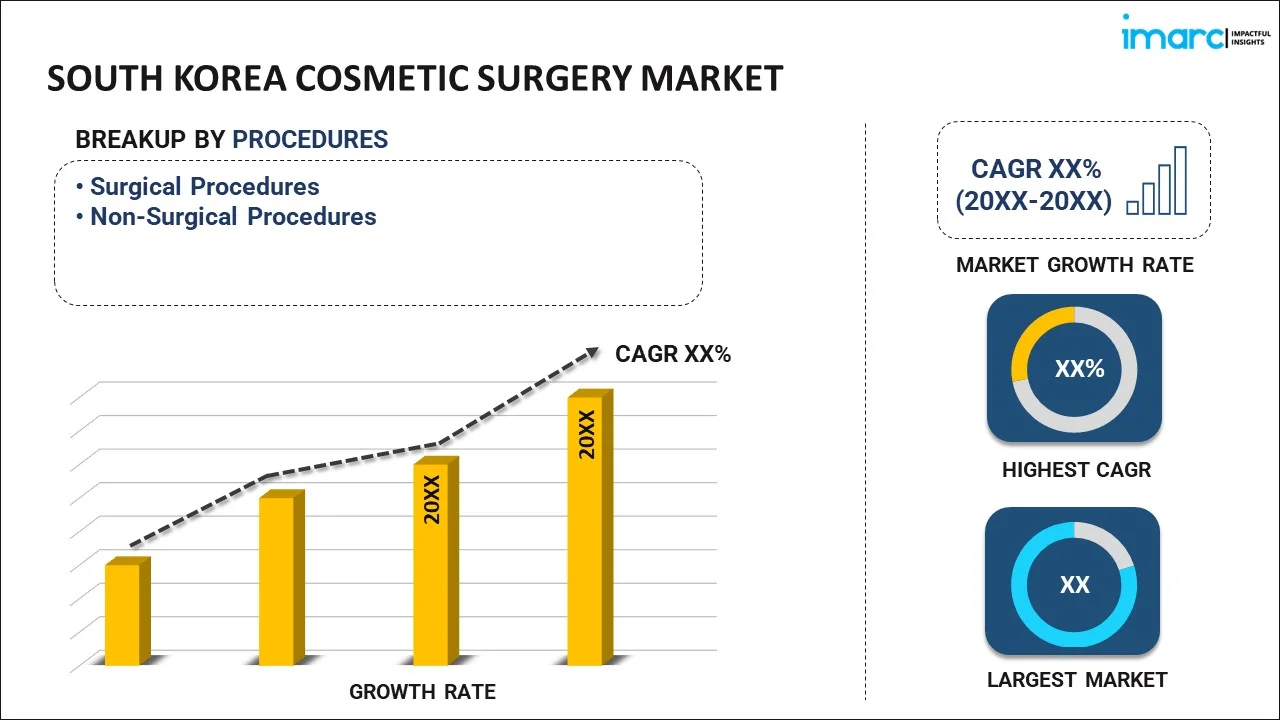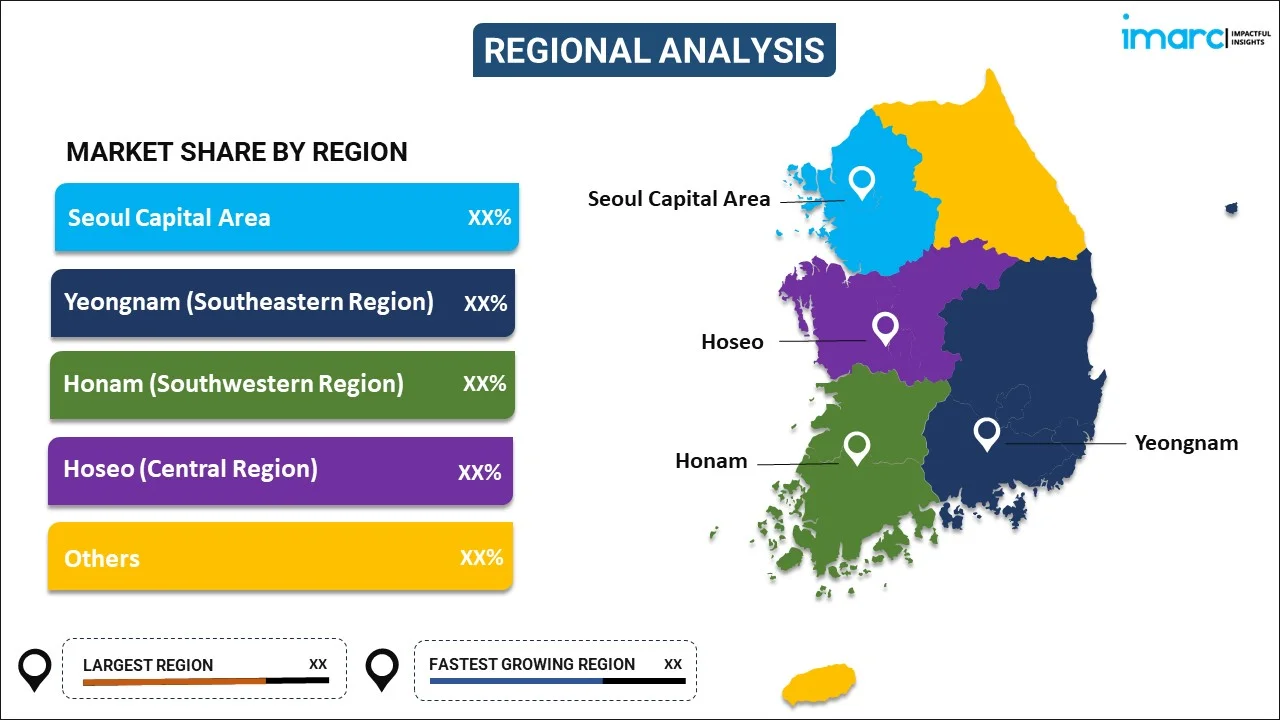
South Korea Cosmetic Surgery Market Report by Procedure (Surgical Procedures, Non-Surgical Procedures), Gender (Female, Male), Age Group (13 to 29, 30 to 54, 55 and Above), End User (Ambulatory Surgical Facility, Hospitals and Clinics, and Others), and Region 2025-2033
South Korea Cosmetic Surgery Market:
South Korea cosmetic surgery market size reached USD 1.7 Billion in 2024. Looking forward, IMARC Group expects the market to reach USD 3.9 Billion by 2033, exhibiting a growth rate (CAGR) of 8.70% during 2025-2033. The increasing cultural emphasis on self-improvement is stimulating the market growth.
|
Report Attribute
|
Key Statistics
|
|---|---|
|
Base Year
|
2024
|
|
Forecast Years
|
2025-2033
|
|
Historical Years
|
2019-2024
|
|
Market Size in 2024
|
USD 1.7 Billion |
|
Market Forecast in 2033
|
USD 3.9 Billion |
| Market Growth Rate 2025-2033 | 8.70% |
South Korea Cosmetic Surgery Market Analysis:
- Major Market Drivers: Rising advancements in technology and surgical techniques in South Korea enhance safety and effectiveness, attracting international clients and boosting the country's reputation as a leading destination for cosmetic surgery.
- Key Market Trends: The increasing emphasis on minimally invasive procedures, along with the easy availability of financing options, is acting as a significant growth-inducing factor.
- Competitive Landscape: The report has provided a comprehensive analysis of the competitive landscape in the market. Also, detailed profiles of all major companies have been provided.
- Geographical Trends: The Seoul Capital Area is a center for advanced cosmetic surgery techniques and research, while Yeongnam specializes in high-volume procedures and attracts medical tourists. Moreover, Honam focuses on natural and minimally invasive methods. In contrast, Hoseo supports smaller clinics and innovative practices.
- Challenges and Opportunities: The high costs and limited access for some demographics are hampering the market. However, increasing affordability through financing options and expanding services to underserved areas are projected to elevate the market in the coming years.
South Korea Cosmetic Surgery Market Trends:
Increasing Demand for Medical Tourism Services
South Korea attracts many international patients due to its advanced cosmetic surgery techniques and affordable prices. For example, in May 2024, according to a report published by the Ministry of Health and Welfare, South Korea reported over 600,000 international patients in 2023, with significant growth in dermatology and plastic surgery services. The surge underscores the country's expanding role as a leading medical tourism hub, particularly in cosmetic surgery, attracting patients from Japan, Taiwan, and beyond. This influx boosts the South Korea cosmetic surgery market share, especially from neighboring countries, driving growth in procedures and solidifying the country's position as a key hub for medical tourism in Asia.
Growing Popularity of Non-Surgical Procedures
Non-surgical cosmetic treatments, such as fillers and Botox, are becoming increasingly popular due to their minimal recovery time and lower cost compared to surgery. This trend boosts South Korea cosmetic surgery market demand, appealing to both local and international patients seeking quick, effective aesthetic enhancements without invasive procedures. For instance, in June 2024, an article published by the International Society of Aesthetic Plastic Surgery reported an approximately 3.4% increase in aesthetic procedures, highlighting the growing popularity of both surgical and non-surgical options. This trend reflects increasing demand for cosmetic surgery, including in South Korea, with a focus on diverse procedures.
Expanding Market for Anti-Aging Cosmetic Solutions
With an aging population, there is a rising demand for anti-aging treatments in South Korea. This demand is driving growth in the market for advanced cosmetic solutions, such as dermal fillers and PDO threads, which cater to individuals looking to maintain a youthful appearance through less invasive methods. For example, in January 2024, CG Bio, one of the South Korean companies specializing in biomaterials, expanded into the U.S. market, leveraging its biomaterial technologies for anti-aging and aesthetic procedures. This growth aligns with South Korea's strategic focus on the aging population and rising demand for cosmetic solutions like fillers and PDO threads.
South Korea Cosmetic Surgery Industry Segmentation
IMARC Group provides an analysis of the key trends in each segment of the market, along with the South Korea cosmetic surgery market forecasts at the country and regional levels for 2025-2033. Our report has categorized the market based on the procedure, gender, age group, and end user.
Breakup by Procedure:

- Surgical Procedures
- Breast Augmentation
- Liposuction
- Eyelid Surgery
- Abdominoplasty
- Rhinoplasty
- Others
- Non-Surgical Procedures
- Botulinum Toxin
- Hyaluronic Acid
- Hair Removal
- Nonsurgical Fat Reduction
- Photo Rejuvenation
- Others
The report has provided a detailed breakup and analysis of the market based on the procedure. This includes surgical procedures (breast augmentation, liposuction, eyelid surgery, abdominoplasty, rhinoplasty, and others) and non-surgical procedures (botulinum toxin, hyaluronic acid, hair removal, nonsurgical fat reduction, photo rejuvenation, and others).
South Korea's cosmetic surgery landscape features popular surgical procedures like breast augmentation, liposuction, eyelid surgery, abdominoplasty, and rhinoplasty. Non-surgical options, such as botulinum toxin, hyaluronic acid fillers, hair removal, non-surgical fat reduction, and photo rejuvenation, also cater to diverse aesthetic needs. As per the South Korea cosmetic surgery market analysis report, this is driving the growth of the segment.
Breakup by Gender:
- Female
- Male
The report has provided a detailed breakup and analysis of the market based on the gender. This includes female and male.
In South Korea, cosmetic surgery is popular among both women and men, with women often opting for procedures like double eyelid surgery and rhinoplasty. Meanwhile, men increasingly seek treatments for facial contouring and anti-aging, reflecting the evolving South Korea cosmetic surgery market outlook toward diverse demographic demands.
Breakup by Age Group:
- 13 to 29
- 30 to 54
- 55 and Above
The report has provided a detailed breakup and analysis of the market based on the age group. This includes 13 to 29, 30 to 54, and 55 and above.
According to the South Korea cosmetic surgery market analysis report, those aged 13 to 29 often seek procedures like rhinoplasty and double eyelid surgery. In contrast, individuals aged 30 to 54 prefer anti-aging treatments such as facelifts and Botox. Those 55 and above usually opt for more advanced facial rejuvenation procedures.
Breakup by End User:
- Ambulatory Surgical Facility
- Hospitals and Clinics
- Others
The report has provided a detailed breakup and analysis of the market based on the end user. This includes ambulatory surgical facility, hospitals and clinics, and others.
In South Korea, cosmetic surgery is performed across various settings, including ambulatory surgical facilities, hospitals, and specialized clinics. These locations offer a range of procedures, from minimally invasive treatments to complex surgeries, ensuring patients have access to advanced techniques and personalized care.
Breakup by Region:

- Seoul Capital Area
- Yeongnam (Southeastern Region)
- Honam (Southwestern Region)
- Hoseo (Central Region)
- Others
The report has also provided a comprehensive analysis of all the major regional markets, which include Seoul Capital Area, Yeongnam (Southeastern Region), Honam (Southwestern Region), Hoseo (Central Region), and others.
In South Korea, the Seoul Capital Area is renowned for cutting-edge cosmetic surgery, thereby attracting many international clients seeking advanced treatments. Moreover, Yeongnam focuses on high-quality surgical procedures and caters to medical tourists. According to the South Korea cosmetic surgery market outlook report, Honam emphasizes combining traditional techniques with modern practices, while Hoseo supports smaller, innovative cosmetic clinics and new technologies. Meanwhile, other regions contribute by offering specialized services and incorporating local expertise and traditional beauty practices, providing a wide range of cosmetic surgery options to meet diverse patient needs across the country.
Competitive Landscape:
The South Korea cosmetic surgery market research report has also provided a comprehensive analysis of the competitive landscape in the market. Competitive analysis, such as market structure, key player positioning, top winning strategies, competitive dashboard, and company evaluation quadrant, has been covered in the report. Also, detailed profiles of all major companies have been provided.
South Korea Cosmetic Surgery Market Recent Developments:
- May 2024: South Korean startup MediThinQ launched its SCOPEYE 3D microsurgery solution, which uses the latest eyes-display technology for improving precision across medical specialties.
- May 2024: According to a report published by the Ministry of Health and Welfare, South Korea reported over 600,000 international patients, with significant growth in dermatology and plastic surgery services. This surge underscores the country's expanding role as a leading medical tourism hub, particularly in cosmetic surgery, attracting patients from Japan, Taiwan, and beyond.
- January 2024: CG Bio, a South Korean company specializing in biomaterials, expanded into the U.S. market, leveraging its biomaterial technologies for anti-aging and aesthetic procedures.
South Korea Cosmetic Surgery Market Report:
| Report Features | Details |
|---|---|
| Base Year of the Analysis | 2024 |
| Historical Period | 2019-2024 |
| Forecast Period | 2025-2033 |
| Units | Billion USD |
| Scope of the Report | Exploration of Historical Trends and Market Outlook, Industry Catalysts and Challenges, Segment-Wise Historical and Predictive Market Assessment:
|
| Procedures Covered |
|
| Genders Covered | Female, Male |
| Age Groups Covered | 13 to 29, 30 to 54, 55 and Above |
| End Users Covered | Ambulatory Surgical Facility, Hospitals and Clinics, Others |
| Regions Covered | Seoul Capital Area, Yeongnam (Southeastern Region), Honam (Southwestern Region), Hoseo (Central Region), Others |
| Customization Scope | 10% Free Customization |
| Post-Sale Analyst Support | 10-12 Weeks |
| Delivery Format | PDF and Excel through Email (We can also provide the editable version of the report in PPT/Word format on special request) |
Key Questions Answered in This Report:
- How has the South Korea cosmetic surgery market performed so far, and how will it perform in the coming years?
- What has been the impact of COVID-19 on the South Korea cosmetic surgery market growth?
- What is the breakup of the South Korea cosmetic surgery market on the basis of procedure?
- What is the breakup of the South Korea cosmetic surgery market on the basis of gender?
- What is the breakup of the South Korea cosmetic surgery market on the basis of age group?
- What is the breakup of the South Korea cosmetic surgery market on the basis of end user?
- What are the various stages in the value chain of the South Korea cosmetic surgery market?
- What are the key driving factors and challenges in South Korea cosmetic surgery?
- What is the structure of the South Korea cosmetic surgery market, and who are the key players?
- What is the degree of competition in the South Korea cosmetic surgery market?
Key Benefits for Stakeholders:
- IMARC’s industry report offers a comprehensive quantitative analysis of various market segments, historical and current market trends, market forecasts, and dynamics of the South Korea cosmetic surgery market from 2019-2033.
- The research report provides the latest information on the market drivers, challenges, and opportunities in the South Korea cosmetic surgery market.
- The study maps the leading, as well as the fastest-growing, markets. It further enables stakeholders to identify the key country-level markets within the region.
- Porter's five forces analysis assists stakeholders in assessing the impact of new entrants, competitive rivalry, supplier power, buyer power, and the threat of substitution. It helps stakeholders to analyze the level of competition within the South Korea cosmetic surgery industry and its attractiveness.
- The competitive landscape allows stakeholders to understand their competitive environment and provides insight into the current positions of key players in the market.
Need more help?
- Speak to our experienced analysts for insights on the current market scenarios.
- Include additional segments and countries to customize the report as per your requirement.
- Gain an unparalleled competitive advantage in your domain by understanding how to utilize the report and positively impacting your operations and revenue.
- For further assistance, please connect with our analysts.
 Inquire Before Buying
Inquire Before Buying
 Speak to an Analyst
Speak to an Analyst
 Request Brochure
Request Brochure
 Request Customization
Request Customization




.webp)




.webp)












